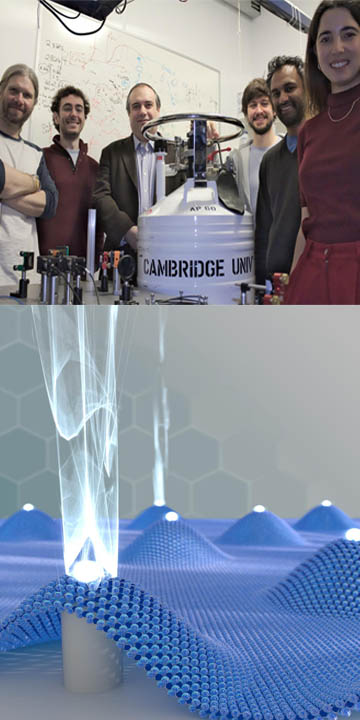
Top: The U.K. members of the research team. Bottom: Artist’s conception of single photons emitted from quantum dots in supported layered semiconductors. [Images: Pawel Latawiec/Harvard University/Graphene Flagship]
Quantum light emitters, or quantum dots, have only shown up randomly in nanoscale-thin semiconductors—that is, until now. A group based in the United Kingdom has created planned, spectrally stable arrays of quantum light emitters in semiconductor monolayers (Nature Comms., doi: 10.1038/ncomms15093).
Pillar by pillar
The atomically thin semiconductors studied by researchers from Cambridge University, U.K., and Harvard University, USA, belong to the transition metal dichalcogenides, which consist of one semiconductor atom and two anions. Previously, scientists have found single-photon emitters located in single layers of tungsten diselenide and tungsten disulfide. However, these emitters occur randomly and in small numbers, thus hampering studies of them.
To stimulate the formation of emitter arrays, the Cambridge-Harvard team etched tiny pillars—between 60 and 190 nm tall and 150 nm wide— into silica substrates. Next, the researchers exfoliated ultrathin layers of the dichalcogenides and suspended them on top of the pillared substrates.
Height matters
For the single layers of tungsten diselenide, optical microscopy and spectroscopy revealed that the quantum emitters had a much higher probability of being located above one of the substrate pillars, especially the taller pillars. The shortest pillars produced emitters with multiple emission lines, and the 190-nm pillars were much more likely to result in a better isolated light-emitting dot with a single emission peak. Even tests with nano-sized diamonds that were placed on a silica substrate created tiny quantum emitters. For the single layers of tungsten disulfide—a material that only has one previous report of single-photon emission—the team found emitters on roughly half of the 190-nm pillars, but not one on the shortest pillars.
According to the research team, the ability to make repeatable arrays of these single-photon emitters should lead to better experimental studies of their properties. Future scientists may be able to fine-tune optical emission by shaping the tiny structures on the substrates.
